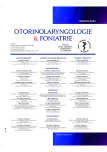Biological importance and development of upper respiratory tract microbiome
Authors:
E. Konečná 1; P. Vídeňská 1; M. Urík 2
Authors‘ workplace:
RECETOX, Přírodovědecká fakulta, Masarykova univerzita, Brno
1; Klinika dětské otorinolaryngologie Fakultní nemocnice Brno a Lékařské fakulty Masarykovy univerzity v Brně
2
Published in:
Otorinolaryngol Foniatr, 69, 2020, No. 3, pp. 135-138.
Category:
Review Article
Overview
Microorganisms present in the upper respiratory tract play an important role not only as agents of acute or chronic diseases, but also as a natural barrier against pathogens. This article summarizes the knowledge about the structure and importance of the upper respiratory tract microbiome and the factors that affect it.
Keywords:
Microbiome – colonisation – upper respiratory tract
Sources
1. Adar, S. D., Huffnagle, G. B., Curtis, J. L.: The respiratory microbiome: an underappreciated player in the human response to inhaled pollutants? Ann Epidemiol, 26, 2016, 5, s. 355–359.
2. Arcavi, L., Benowitz, N. L.: Cigarette smoking and infection. Arch Intern Med, 164, 2004, 20, s. 2206–2216.
3. Barberán, A., Dunn, R. R., Reich, B. J., et al.: The ecology of microscopic life in household dust. Proc Biol Sci, 282, 2015, 1814, 212–220.
4. Biesbroek, G., Bosch, A. A., Wang, X., et al.: The impact of breastfeeding on nasopharyngeal microbial communities in infants. Am J Respir Crit Care Med, 190, 2014, 3, s. 298–308.
5. Biesbroek, G., Tsivtsivadze, E., Sanders, E. A., et al.: Early respiratory microbiota composition determines bacterial succession patterns and respiratory health in children. Am J Respir Crit Care Med, 190, 2014, 11, s. 1283–1292.
6. Bosch, A. A., Biesbroek, G., Trzcinski, K., et al.: Viral and bacterial interactions in the upper respiratory tract. PLoS Pathog, 9, 2013, 1, e1003057.
7. Brook, I., Gober, A. E.: Recovery of potential pathogens and interfering bacteria in the nasopharynx of smokers and nonsmokers. Chest, 127, 2005, 6, s. 2072–2075.
8. Brugger, S. D., Bomar, L., Lemon, K. P.: Commensal-pathogen interactions along the human nasal passages. PLoS Pathog, 12, 2016, 7, e1005633.
9. De Boeck, I., Wittouck, S., Wuyts, S., et al.: Comparing the healthy nose and nasopharynx microbiota reveals continuity as well as niche-specificity. Front Microbiol, 8, 2017, s. 2372.
10. El Ahmer, O. R., Essery, S. D., Saadi, A. T., et al.: The effect of cigarette smoke on adherence of respiratory pathogens to buccal epithelial cells. FEMS Immunol Med Microbiol, 23, 1999, 1, s. 27–36.
11. Gutarowska, B., Szulc, J., Nowak, A., et al.: Dust at various workplaces-microbiological and toxicological threats. Int J Environ Res Public Health, 15, 2018, s. 877.
12. Huffnagle, G. B., Dickson, R. P., Lukacs, N. W.: The respiratory tract microbiome and lung inflammation: a two-way street. Mucosal Immunol, 10, 2017, 2, s. 299–306.
13. Jain, N., Lodha, R., Kabra, S. K.: Upper respiratory tract infections. Indian J Pediatr, 68, 2001, 12, s. 1135–1138.
14. Liu, C. M., Price, L. B., Hungate, B. A., et al.: Staphylococcus aureus and the ecology of the nasal microbiome. Sci Adv, 1, 2015, 5, e1400216.
15. Man, W. H., de Steenhuijsen Piters, W. A., Bogaert, D.: The microbiota of the respiratory tract: gatekeeper to respiratory health. Nat Rev Microbiol, 15, 2017, 5, s. 259–270.
16. Meadow, J. F., Altrichter, A. E., Kembel, S. W., et al.: Indoor airborne bacterial communities are influenced by ventilation, occupancy, and outdoor air source. Indoor Air, 24, 2014, 1, s. 41–48.
17. Proctor, D. M., Relman, D. A.: The Landscape Ecology and Microbiota of the Human Nose, Mouth, and Throat. Cell Host Microbe, 21, 2017, 4, s. 421–432.
18. Ramakrishnan, V. R., Holt, J., Nelson, L. F., et al.: Determinants of the nasal microbiome: pilot study of effects of intranasal medication use. Allergy Rhinol (Providence), 9, 2018, 2152656718789519.
19. Santee, C. A., Nagalingam, N. A., Faruqi, A. A., et al.: Nasopharyngeal microbiota composition of children is related to the frequency of upper respiratory infection and acute sinusitis. Microbiome, 4, 2016, 34.
20. Sapkota, A. R., Berger, S., Vogel, T. M.: Human Pathogens Abundant in the Bacterial Metagenome of Cigarettes. Environ Health Perspect, 118, 2010, 3, s. 351–356.
21. Sender, R., Fuchs, S., Milo, R.: Revised estimates for the number of human and bacteria cells in the body. PLoS Biol, 14, 2016, 8, e1002533.
22. Shilts, M. H., Rosas-Salazar, C., Tovchigrechko, A., et al.: Minimally invasive sampling method identifies differences in taxonomic richness of nasal microbiomes in young infants associated with mode of delivery. Microb Ecol, 71, 2016, 1, s. 233–242.
23. Tamashiro, E., Xiong, G., Anselmo-Lima, W. T., et al.: Cigarette smoke exposure impairs respiratory epithelial ciliogenesis. Am J Rhinol Allergy, 23, 2009, 2, s. 117–122.
24. Tran, N. P., Vickery, J., Blaiss, M. S.: Management of rhinitis: allergic and non-allergic. Allergy Asthma Immunol Res, 3, 2011, 3, s. 148–156.
25. Wang, Y., Li, X., Ge, T., et al.: Probiotics for prevention and treatment of respiratory tract infections in children: A systematic review and meta-analysis of randomized controlled trials. Medicine, 95, 2016, 31, e4509.
26. Whelan, F. J., Verschoor, C. P., Stearns, J. C., et al.: The loss of topography in the microbial communities of the upper respiratory tract in the elderly. Ann Am Thorac Soc, 11, 2014, 4, s. 513–521.
27. Wostmann B. S.: The germfree animal in nutritional studies. Annu Rev Nutr, 1, 1981, s. 257–279.
28. Yun, Y., Srinivas, G., Kuenzel, S., et al.: Environmentally Determined Differences in the Murine Lung Microbiota and Their Relation to Alveolar Architecture. PloS One, 9, 2014, 12, e113466.
Labels
Audiology Paediatric ENT ENT (Otorhinolaryngology)Article was published in
Otorhinolaryngology and Phoniatrics

2020 Issue 3
Most read in this issue
- Orální probiotika
- Biological importance and development of upper respiratory tract microbiome
- The benefit of magnetic resonance in diagnosis of Ménière's disease
- Tracheostomy in children - a 7-year experience at Department of Otorhinolaryngology and Head and Surgery at University Hospital Hradec Králové
